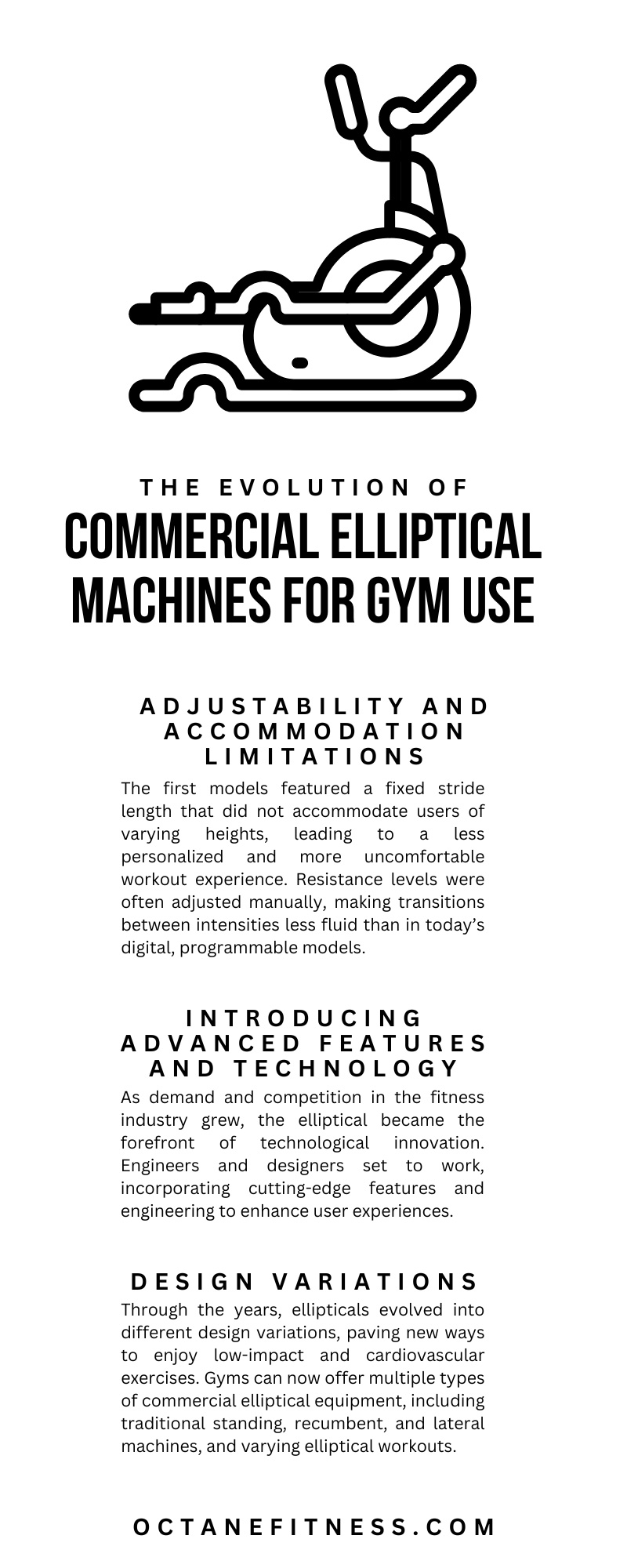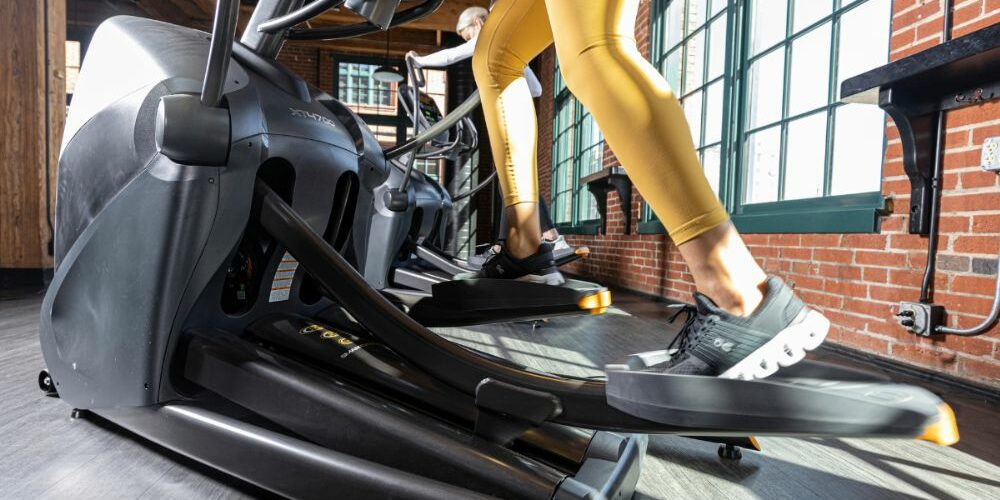The evolution of fitness equipment mirrors the growth of our understanding of health and exercise. Equipment has evolved to meet our needs as we’ve learned more about how our bodies move and the types of exercise that benefit us most. Today’s ellipticals are marvels of engineering, minimizing strain on joints while maximizing cardiovascular and muscle-building results. They’re smarter, too—equipped with features that track every aspect of a workout and integrate seamlessly with our connected lifestyles. This evolution is crucial because as the machines get better, they start to feel less like machines and more like fitness journey partners—understandable, accessible, and right there with you, stride for stride.
Explore the evolution of commercial elliptical machines for gym use and discover how they have become the ultimate cardio partner and gym staple.
Early Designs and Limitations
The first commercial ellipticals were a wonder of their time. However, early elliptical designs had their shortcomings.
Adjustability and Accommodation Limitations
The first models featured a fixed stride length that did not accommodate users of varying heights, leading to a less personalized and more uncomfortable workout experience. Resistance levels were often adjusted manually, making transitions between intensities less fluid than in today’s digital, programmable models.
Technological Setbacks
Early ellipticals also lacked the sophisticated tracking capabilities now standard in modern units; they could not monitor metrics like heart rate, calories burned, or distance traveled with precision. Despite these constraints, these rudimentary models laid the groundwork for the following technological leaps, leading elliptical machines to become highly adaptable and widely appreciated fitness equipment in gyms worldwide.
Physical and Aesthetic Challenges
Initial elliptical machine generations featured bulky frames and heavy parts, often resulting in a dominating and imposing presence on the gym floor. Functionality took precedence over form, with little attention paid to the machine’s aesthetic appeal—a stark contrast to today’s sleek and modern designs. Gym elliptical machines were typically constructed from large metal components, making them cumbersome to move and unappealing to the eye.
Octane’s Pro310 standing elliptical is a testament to the elliptical’s aesthetic and performance evolution through the years, offering a compact design that maximizes gym spaces. You can effortlessly implement a modern elliptical in your gym without worrying about floor space or lack of aesthetic cohesion. Advanced ellipticals achieved the perfect balance of function and appearance that earlier models lacked.
Introducing Advanced Features and Technology
As demand and competition in the fitness industry grew, the elliptical became the forefront of technological innovation. Engineers and designers set to work, incorporating cutting-edge features and engineering to enhance user experiences.
Motorized Inclines
Motorized inclines marked a pivotal advancement in elliptical design, allowing users to customize their workouts and engage different muscle groups. Users can adjust the elliptical’s ramp angle, effectively targeting the glute and leg muscles as if climbing a hill. Varying incline levels not only simulate the challenge of outdoor terrains but also add diversity to the exercise routine, preventing the plateau effect and promoting continued fitness progress.
Adjustable Strides
Adjustable stride technology enhanced the elliptical’s customizability and inclusivity, allowing stride length modifications and catering to the natural gait of users of different heights and leg lengths. Adjustable strides simulate a more personalized running or walking motion, improving comfort and reducing injury risk with proper joint alignment and muscular engagement.
Advanced Ergonomics
Ergonomics reshaped all fitness equipment. With ergonomic ingenuity, comfort and enhanced biomechanics became a key focus in modern elliptical designs, guaranteeing gym-goers comfortable, safer, and more enjoyable workouts. Multi-grip handles, shock absorption, and padded pedals are just a few of the many ergonomic advancements added to modern ellipticals.
Customizable Resistance Levels
Gone are the days of having to switch between machines to change the intensity of your workout. Cutting-edge elliptical machines now offer dozens of resistance levels, allowing users to fine-tune their workout to the exact level of challenge they seek. This adaptability makes workouts more effective and caters to the ubiquitous personalization that modern gym-goers expect.
Interactive Console Displays
Interactive console displays brought new depths to elliptical exercises, enhancing engagement, entertainment, and workout personalization and tracking. High-definition touchscreen panels provide users with real-time metrics, such as heart rate, distance covered, and calories burned, allowing for a more structured and goal-oriented workout.
Smart consoles’ access to various programs and virtual landscapes simulates outdoor conditions, transforming routine exercises into interactive experiences. Additionally, many modern consoles are compatible with fitness apps, enabling users to track their progress over time, set customized workout plans, and share their achievements on social media. This level of interactivity not only aids in motivation but also adds an element of fun to the workout.
Fitness Apps and Wearable Devices
In a world where connectivity is king, it’s no surprise that ellipticals have followed in line. Many models are now compatible with popular fitness apps and wearable devices, allowing users to seamlessly integrate their elliptical workouts into their broader health and fitness ecosystem. Tracking progress and setting goals has never been easier.
Design Variations
Through the years, ellipticals evolved into different design variations, paving new ways to enjoy low-impact and cardiovascular exercises. Gyms can now offer multiple types of commercial elliptical equipment, including traditional standing, recumbent, and lateral machines, and varying elliptical workouts.
Recumbent Elliptical Trainers
Recumbent elliptical trainers like the xRide XR6000s features a supportive seat with a backrest, allowing users to lean back comfortably. The recumbent position reduces the weight-bearing aspect of the workout, providing an even lower impact experience than the standing version while still delivering the full-body benefits.
Lateral Ellipticals
Lateral ellipticals took the concept of the standard elliptical and turned it on its side. The side-to-side gliding motion targets the often-neglected muscle groups of the inner and outer thighs, as well as the obliques. Lateral ellipticals add a new dimension to workouts, offering a dynamic and challenging alternative to the front-to-back stride of traditional ellipticals.
The commercial elliptical machine’s evolution is far from over. With the growing intersection of fitness and technology, we can expect even more immersive workout experiences. What began as a rudimentary tool has evolved into sophisticated cardio equipment, enhancing gyms and improving workouts. At Octane, our ellipticals showcase the latest evolutions, offering effective and beneficial workouts. Offer the latest innovations at your gym with Octane Fitness.

